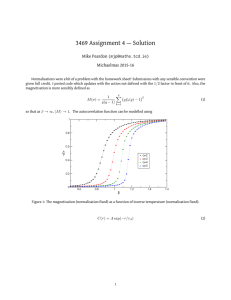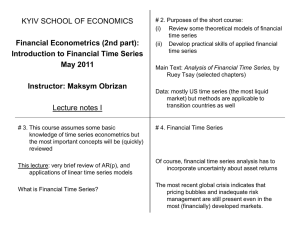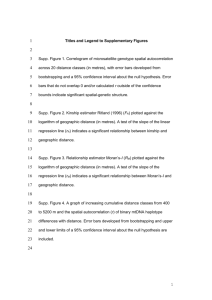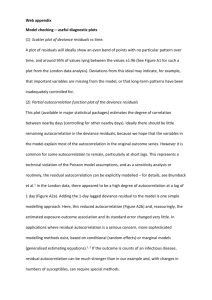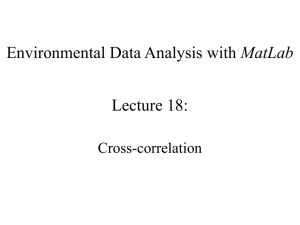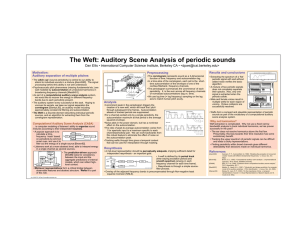Document 10709041
advertisement
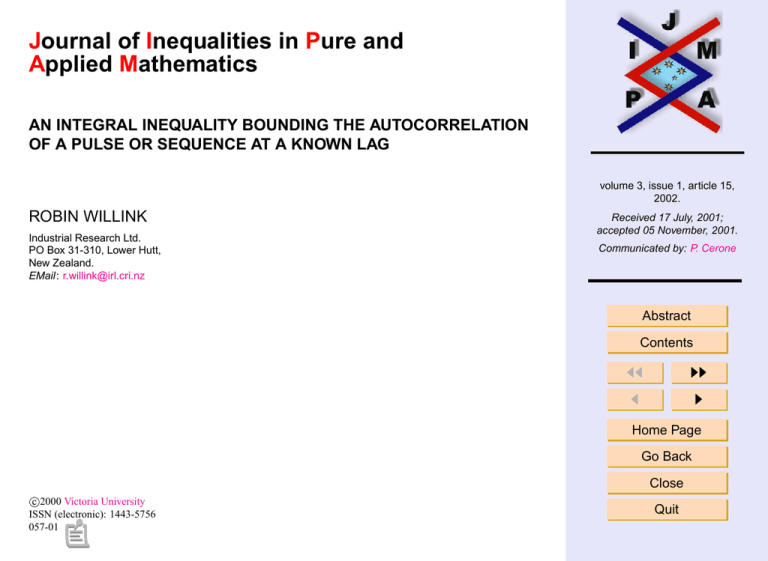
Journal of Inequalities in Pure and
Applied Mathematics
AN INTEGRAL INEQUALITY BOUNDING THE AUTOCORRELATION
OF A PULSE OR SEQUENCE AT A KNOWN LAG
volume 3, issue 1, article 15,
2002.
ROBIN WILLINK
Industrial Research Ltd.
PO Box 31-310, Lower Hutt,
New Zealand.
EMail: r.willink@irl.cri.nz
Received 17 July, 2001;
accepted 05 November, 2001.
Communicated by: P. Cerone
Abstract
Contents
JJ
J
II
I
Home Page
Go Back
Close
c
2000
Victoria University
ISSN (electronic): 1443-5756
057-01
Quit
Abstract
R b−t
Rb
This paper gives best bounds for the ratio a f(x) f(x + t) dx/ a f 2 (x) dx for
any square-summable real function f(x) on the interval (a, b]. Similarly, bounds
are established for the autocorrelation of any pulse or finite-length sequence at
any known lag, and the family of pulses and sequences attaining these bounds
is identified. The form of this family is related to a half-cycle of a sinusoid.
Stronger bounds are suggested for pulses known to be non-negative and unimodal or concave.
2000 Mathematics Subject Classification: 26D15, 26D07
Key words: Inequalities, Auto-correlation, Bounds.
The author is grateful to Dr. C. Atkin of Victoria University of Wellington, New
Zealand, and to colleagues at Industrial Research Limited for helpful suggestions
in the preparation of this paper.
Contents
1
Introduction . . . . . . . . . . . . . . . . . . . . . . . . . . . . . . . . . . . . . . . . . 3
2
Analysis . . . . . . . . . . . . . . . . . . . . . . . . . . . . . . . . . . . . . . . . . . . . 6
3
Unimodal functions . . . . . . . . . . . . . . . . . . . . . . . . . . . . . . . . . . . 14
4
Concave functions . . . . . . . . . . . . . . . . . . . . . . . . . . . . . . . . . . . . 17
5
Summary . . . . . . . . . . . . . . . . . . . . . . . . . . . . . . . . . . . . . . . . . . . 19
References
An Integral Inequality Bounding
the Autocorrelation of a Pulse
or Sequence at a Known Lag
Robin Willink
Title Page
Contents
JJ
J
II
I
Go Back
Close
Quit
Page 2 of 21
J. Ineq. Pure and Appl. Math. 3(1) Art. 15, 2002
http://jipam.vu.edu.au
1.
Introduction
This paper presents a derivation of the inequality
R b−t
!
f
(x)
f
(x
+
t)
dx
π
a
(1.1)
≤ cos b−a Rb
2
+1
f
(x)
dx
t
a
0<t≤b−a
for any square-summable real function f (x) on the interval (a, b], and demonstrates that the bound is the best possible. The notation d·e denotes the ‘lowest
integer not less than’ function. The result is obtained by a shift in origin after
derivation of the inequality
π
0 < t ≤ T,
(1.2)
|A(t)| ≤ cos
dT /te + 1
where
Robin Willink
Title Page
Contents
R T −t
(1.3)
An Integral Inequality Bounding
the Autocorrelation of a Pulse
or Sequence at a Known Lag
A(t) ≡
0
f (x) f (x + t) dx
RT
f 2 (x) dx
0
is the autocorrelation function of a pulse of duration T . As the notation suggests,
the autocorrelation function is principally thought of as a function of the lag
t for known f (x) and T . In that context familiar results are A(0) = 1 and
|A(t)| ≤ 1. Here the lag (as a proportion of the pulse duration) is deemed to be
known and the bounds, equation (1.2), are obtained for any square-summable
pulse f (x). If T is unknown then the parameter of interest is the lag proportion
t/T , and equation (1.2) can be written accordingly. Also if the pulse duration
JJ
J
II
I
Go Back
Close
Quit
Page 3 of 21
J. Ineq. Pure and Appl. Math. 3(1) Art. 15, 2002
http://jipam.vu.edu.au
is known only to be less than or equal to some figure T then the same bounds
hold. Equation (1.2) is obtained by first developing a discrete analogy which
bounds the autocorrelation of a real sequence.
The motivating example for this work was the placement of bounds on a
correlation arising in medical Doppler ultrasound, where the goal is the description of blood-flow. Scatterers of ultrasound (groupings of red cells) within
the blood can be regarded as being distributed uniformly and randomly within
an insonated volume. Therefore the power of the signal measured on reception at the transmitter-receiver is the sum of many contributions with uniform
random phases. A short time later the scatterers have moved with the rest of
the blood but with little change in their relative positions. Some scatterers have
entered the insonated volume and some have left. The correlation between the
powers received at these two times is related to the velocity of blood v, the time
interval τ , and the intensity profile of the ultrasound beam. The ‘pulse’ f (x)
is this intensity profile as a one-dimensional function of space in the direction
of the blood velocity. So the product |vτ | is t, and the spatial extent of the intensity function is T . If sides lobes are ignored this extent is the width of the
central lobe of the intensity function. Even if the shape of the intensity function is unknown the correlation between the powers at the two times is bounded
according to equation (1.2) and more strongly according to the results for unimodal and concave functions obtained in Sections 3 and 4. If the correlation is
determined experimentally this in turn bounds v.
There appears to be little published regarding such bounds on an autocorrelation. Communications engineers are more interested in the design of sequences
with desirable (small) autocorrelation over a range of lags. Upper bounds have
been given for the autocorrelation of maximal-length pseudo-random sequences
An Integral Inequality Bounding
the Autocorrelation of a Pulse
or Sequence at a Known Lag
Robin Willink
Title Page
Contents
JJ
J
II
I
Go Back
Close
Quit
Page 4 of 21
J. Ineq. Pure and Appl. Math. 3(1) Art. 15, 2002
http://jipam.vu.edu.au
[1], while lower bounds for the maximum magnitude of cross-correlation functions and autocorrelation functions for sets of complex-valued sequences have
been considered [2].
An Integral Inequality Bounding
the Autocorrelation of a Pulse
or Sequence at a Known Lag
Robin Willink
Title Page
Contents
JJ
J
II
I
Go Back
Close
Quit
Page 5 of 21
J. Ineq. Pure and Appl. Math. 3(1) Art. 15, 2002
http://jipam.vu.edu.au
2.
Analysis
Equation (1.2) is derived by considering the definite integral to be a sum of
infinitesimal terms. So we first study the autocorrelation of a finite real sequence
of P values {fn }, n = 1, 2, . . . , P , at positive lag p, which is
PP −p
n=1 fn fn+p
(2.1)
Ap ≡ P
.
P
2
f
n=1 n
Then we increase p and P without limit while preserving the ratio p/P = t/T .
Write P = M p+q where M = bP/pc and 0 ≤ q < p, and b·c is ‘the greatest
integer not greater than’ function. The sequence can be split into p interleaving
subsequences each containing elements spaced p apart. The jth subsequence,
{fj , fj+p , . . . , fj+(Lj −1)p } has length Lj , where Lj = M + 1 for 1 ≤ j ≤ q and
Lj = M for q + 1 ≤ j ≤ p. Equation (2.1) can then be written as
Ap =
where
aj =
Lj
X
and
bj =
k=1
Lj
X
2
fj+(k−1)p
.
Evidently aj /bj is the autocorrelation of the jth subsequence with lag 1. Because each bj is non-negative it follows that Ap is bounded between the maximum and minimum values of aj /bj , so
j
Title Page
JJ
J
k=1
|Ap | ≤ max{|aj /bj |}.
Robin Willink
Contents
a1 + . . . + ap
b1 + . . . + bp
fj+(k−1)p fj+kp
An Integral Inequality Bounding
the Autocorrelation of a Pulse
or Sequence at a Known Lag
II
I
Go Back
Close
Quit
Page 6 of 21
J. Ineq. Pure and Appl. Math. 3(1) Art. 15, 2002
http://jipam.vu.edu.au
Any of the subsequences can be relabelled {F1 , F2 , . . . FN } where N = M or
N = M + 1 so the problem reduces to bounding the autocorrelation of this new
sequence at lag 1, i.e. bounding
PN −1
Fn Fn+1
∗
(2.2)
A ≡ n=1
PN
2
i=1 Fn
for any sequence {Fn } and choosing N = M or N = M + 1 to give the least
lower bound and greatest upper bound.
Let ρ be an extremum of A∗ with respect to each element of {Fn }. Setting
∂A∗ /∂Fn = 0 gives
(Fn−1 + Fn+1 )
N
X
Fi2
= 2Fn
i=1
N
−1
X
Robin Willink
Fi Fi+1
n = 1, . . . , N
i=1
Title Page
if we define F0 ≡ 0 and FN +1 ≡ 0. At this extremum the right-hand side of
equation (2.2) is ρ, so this rearranges to the recurrence relation
(2.3)
Fn+1 = 2ρ Fn − Fn−1 .
The general solution to equation (2.3) with F0 = 0 is
−1
Fn = K sin(n cos
ρ)
An Integral Inequality Bounding
the Autocorrelation of a Pulse
or Sequence at a Known Lag
n = 0, . . . , N
where K is an arbitrary constant. This equation must be the general solution
because it satisfies equation (2.3) and F0 = 0 while keeping F1 arbitrary. From
the further condition FN +1 = 0 we identify possible values of ρ to be
(2.4)
ρ = cos Nkπ
+1
Contents
JJ
J
II
I
Go Back
Close
Quit
Page 7 of 21
J. Ineq. Pure and Appl. Math. 3(1) Art. 15, 2002
http://jipam.vu.edu.au
where k is an integer. So A∗ takes its global maximum and minimum values of
(2.5)
ρmax = cos Nπ+1
and
ρmin = − cos Nπ+1
with corresponding sequences
(2.6)
Fn = K sin Nnπ
+1
and
Fn = (−1)n K sin
nπ
N +1
,
whose elements are equally spaced samples of half-cycles of sinusoids.
An alternative derivation of equation (2.4) follows from writing the righthand side of equation (2.2) as (F0 CF)/(F0 F) where F is the column vector
(F1 , F2 , . . . , FN )0 , and C is the N × N Toeplitz matrix with elements 1/2
in the diagonals immediately either side of the leading diagonal (first superdiagonal and first sub-diagonal), and zero elsewhere. Differentiating with respect to F and setting the result to zero gives CF = ρ F, which is a reexpression of equation (2.3) with F0 = 0 and FN +1 = 0. So the possible
values of ρ and vectors F are the eigenvalues and eigenvectors of C. The
eigenvalues of an N × N matrix with elements c0 in the leading diagonal, c1
in the first super-diagonal, c2 in the first sub-diagonal and zero elsewhere are
c0 + 2(c1 c2 )1/2 cos (kπ/(N + 1)), k = 1, . . . , N [3, p. 284].
Both bounds in equation (2.5) are larger in magnitude when N = M + 1
than when N = M . Also M + 1 = dP/pe. Therefore the autocorrelation of the
original sequence at lag p is bounded by
π
(2.7)
|Ap | ≤ cos
.
dP/pe + 1
An Integral Inequality Bounding
the Autocorrelation of a Pulse
or Sequence at a Known Lag
Robin Willink
Title Page
Contents
JJ
J
II
I
Go Back
Close
Quit
Page 8 of 21
J. Ineq. Pure and Appl. Math. 3(1) Art. 15, 2002
http://jipam.vu.edu.au
If p and P tend to infinity while maintaining the ratio p/P = t/T , the result is
equation (1.2) for the bound on the autocorrelation defined by equation (1.3).
To show this more rigorously define the stepwise function
(n−1)T
P
f (x) = fn
<x≤
nT
P
n = 1, 2, . . . , P,
which has fixed extent T and step length T /P , and define f (x) = 0 outside
(0, T ]. So for integer values of k ≥ 0
(n−1)T
P
fn+k = f (x + kT /P )
<x≤
nT
P
n = 1, 2, . . . , P − k,
from which it follows that
fn fn+k =
An Integral Inequality Bounding
the Autocorrelation of a Pulse
or Sequence at a Known Lag
Robin Willink
P
T
Z
nT /P
f (x)f (x + kT /P ) dx.
(n−1)T /P
P
Form the relevant sums fn fn+k appearing in equation (2.1) with k = p in the
numerator and k = 0 in the denominator, and set t = pT /P to obtain
R T −t
Ap =
0
f (x) f (x + t) dx
.
RT
2 (x) dx
f
0
Title Page
Contents
JJ
J
II
I
Go Back
Close
Recall that T is fixed. Let p and P tend to infinity in a way that maintains the ratio p/P = t/T . No restrictions are placed on the fn values so this enables f (x)
to approach any square-summable function, continuous or otherwise, which is
zero outside (0, T ]. Also the lags t corresponding to neighbouring values of
p become arbitrarily close, so the result is valid for any t where 0 < t ≤ T .
Quit
Page 9 of 21
J. Ineq. Pure and Appl. Math. 3(1) Art. 15, 2002
http://jipam.vu.edu.au
Therefore equation (2.1) becomes equation (1.3), and equation (2.7) becomes
equation (1.2). Thus we have found bounds on the autocorrelation of any pulse
at a lag which is a known proportion of the pulse duration.
If the condition that f (x) = 0 outside (0, T ] is relaxed then equation (1.3)
no longer defines the autocorrelation function but describes a more general situation. The equations derived will still be true, as they do not require anything
of f (x) outside that interval, and by a shift of origin, with T = b − a (for any
real a, b, with a < b), equation (1.2) generalises to the more fundamental result
that is equation (1.1).
The bound in equation (1.2) is given by the stepwise solid line in Figure 1.
The left endpoints of the pieces of this function correspond to integer values of
T /t. For non-integer T /t the positive upper bound is only reached by functions
such as that in Figure 2, (where, for example, t/T = 0.3). The function can only
be non-zero in dT /te (= 4) regions each of duration s = T − (dT /te − 1) t (=
0.1). The points in these regions correspond to elements in the longer subsequences of length M + 1(= 4), in the discrete formulation given above. The
function in each of these regions is of identical arbitrary form, but with a different scale factor. Corresponding points lie on a half-cycle of a sinusoid, as drawn
in Figure 2 for the two modal points, and in accordance with the first sequence in
equation (2.6). The function must be zero in the interleaving dT /te−1 (= 3) regions, containing points corresponding to elements in the shorter subsequences
of length M (= 3). The negative lower bound is reached by such a function if
every second non-zero region is inverted, as in the second sequence in equation
(2.6). Examples like this can be constructed for any lag, which indicates that
the bounds given by equation (1.2) and equation (1.1) are the best possible.
The short-dashed line on Figure 1 gives the quantity cos (π/(T /t + 1))
An Integral Inequality Bounding
the Autocorrelation of a Pulse
or Sequence at a Known Lag
Robin Willink
Title Page
Contents
JJ
J
II
I
Go Back
Close
Quit
Page 10 of 21
J. Ineq. Pure and Appl. Math. 3(1) Art. 15, 2002
http://jipam.vu.edu.au
which is the bound in equation (1.2) without application of the d·e function.
As the lag approaches zero the bound approaches this quantity, which itself approaches cos(πt/T ). Also, using equation (2.6) for sequences with increasing
length, the shape of the pulse maximising the correlation approaches in some
sense the half-cycle sin(πx/T ) for 0 < x ≤ T .
An Integral Inequality Bounding
the Autocorrelation of a Pulse
or Sequence at a Known Lag
Robin Willink
Title Page
Contents
JJ
J
II
I
Go Back
Close
Quit
Page 11 of 21
J. Ineq. Pure and Appl. Math. 3(1) Art. 15, 2002
http://jipam.vu.edu.au
bound
1.0
0.9
0.8
0.7
0.6
An Integral Inequality Bounding
the Autocorrelation of a Pulse
or Sequence at a Known Lag
0.5
0.4
Robin Willink
0.3
0.2
Title Page
0.1
lag t/T
0.0
0
0
1/8 1/5
1
2
3
1/3
4
5
1/2
6
7
lag p (P=14)
8
9
1
10 11 12 13 14
Figure 1: Bounds for the autocorrelation function. Solid line – magnitude of bound for all functions, cos (π/(dT /te + 1)). Short-dashed line –
cos (π/(T /t + 1)). Long-dashed line – apparent upper bound for unimodal
functions. Cross marks – apparent upper bound for concave sequences of length
14. As t/T approaches zero each line approaches cos(πt/T ).
Contents
JJ
J
II
I
Go Back
Close
Quit
Page 12 of 21
J. Ineq. Pure and Appl. Math. 3(1) Art. 15, 2002
http://jipam.vu.edu.au
An Integral Inequality Bounding
the Autocorrelation of a Pulse
or Sequence at a Known Lag
Robin Willink
0
t
t
t
s
T
Title Page
Contents
Figure 2: A function giving maximum correlation when T /t is not an integer. (Here t/T = 0.3.) The function comprises dT /te regions of duration
s = T − (dT /te − 1) t, each with identical arbitrary form but scaled so that
corresponding points lie on a sinusoid, and dT /te − 1 interleaving regions of
zero.
JJ
J
II
I
Go Back
Close
Quit
Page 13 of 21
J. Ineq. Pure and Appl. Math. 3(1) Art. 15, 2002
http://jipam.vu.edu.au
3.
Unimodal functions
Consider the subset of pulses which are non-negative and unimodal, i.e. with a
single modal point or plateau that might contain either extreme point 0 or T . An
example is the central lobe of a sinc, i.e. (sin x)/x, or sinc-squared function,
as might be the form of f (x) in the medical ultrasonics example. The bound of
interest is the upper bound.
The discussion in the previous section suggests that for such functions the
upper bound given in equation (1.2) is only reached when T /t is an integer and
the function comprises T /t level sections each of length t with heights which
are equally spaced samples of a half-sinusoid.
For general values of T /t a Monte Carlo technique was used to find the
unimodal pulse shape maximising the autocorrelation for a given lag. (An analytical derivation was not found.) Random unimodal sequences of length N = 8
were created by the cumulative summation of uniform random numbers either
side of a randomly selected mode. This was carried out 109 times, and for
each lag the sequence giving the maximum autocorrelation was recorded. For
y ≤ 1/2 the sequences suggested were symmetric, so 109 symmetric sequences
of both N = 13 and N = 16 were studied. The sequences and functions
strongly suggested by this technique are stepwise. Consider the autocorrelation
as a function of the lag proportion y ≡ t/T . For y < 1/2 the function suggested is symmetric, stepwise and of the family including Figures 3a and 3b.
For y ≥ 1/2 the function suggested is of the form shown in Figure 3c (or its
reflection about the axis x/T = 1/2).
In Figure 3 the modal region in each case is scaled to have height 1. Assuming these forms are correct, expressions are found for the maximum autocorre-
An Integral Inequality Bounding
the Autocorrelation of a Pulse
or Sequence at a Known Lag
Robin Willink
Title Page
Contents
JJ
J
II
I
Go Back
Close
Quit
Page 14 of 21
J. Ineq. Pure and Appl. Math. 3(1) Art. 15, 2002
http://jipam.vu.edu.au
lation by setting to zero the derivatives of the autocorrelation with respect to the
unknown levels, α (and β), solving a polynomial equation to obtain these levels, and calculating the autocorrelation. Thus the autocorrelation for a unimodal
function is bounded by
5y−1+√(1−2y−3y2 ) 1
≤ y < 14
4y
5
y
1
3y−1+√(1−4y+5y
≤ y < 13
2)
4
(3.1)
0 ≤ A(t) ≤
√
3y−1+ (1+2y−7y 2 )
1
≤ y < 12
4y
3
1√ 1
1
( y − 1)
≤ y < 1.
2
2
The upper bound is continuous and is the long-dashed line in Figure 1.
The two dashed lines on Figure 1 are close between y = 1/5 and y = 1/3
and, by suggestion, will be close for lower values of y also. Therefore, for y ≤
1/3 the short-dashed line provides an approximate bound, and for a unimodal
function the inequality
π
(3.2)
0 ≤ A(t) <≈ cos
0 < Tt ≤ 13
T /t + 1
might be used in place of equation (3.1).
The levels α (and β) in the functions of Figure 3 attaining the upper bound in
equation (3.1) are simply related to this bound. Let V be the upper bound listed
in equation (3.1). Then α = V and β = 1/2 for 1/5 ≤ y < 1/4, α = 1/(2V )
for 1/4 ≤ y < 1/3, α = V for 1/3 ≤ y < 1/2 and α = 2V for 1/2 ≤ y < 1.
As with equation (1.1) an inequality for square-summable functions which
are non-negative and unimodal in (a, b] can be written using equation (3.1) or
equation (3.2).
An Integral Inequality Bounding
the Autocorrelation of a Pulse
or Sequence at a Known Lag
Robin Willink
Title Page
Contents
JJ
J
II
I
Go Back
Close
Quit
Page 15 of 21
J. Ineq. Pure and Appl. Math. 3(1) Art. 15, 2002
http://jipam.vu.edu.au
1-4y
f(x)
1-2y
f(x)
1
α
1
y
β
α
y
y
y
y
y
x /T
T
x /T
0
0
1
(a)
(b)
1
An Integral Inequality Bounding
the Autocorrelation of a Pulse
or Sequence at a Known Lag
Robin Willink
f(x)
1-y
1
Title Page
α
Contents
y
x /T
0
(c)
1
JJ
J
II
I
Go Back
Figure 3: Unimodal functions maximising the autocorrelation at lag y ≡ t/T .
(a) 1/6 ≤ y < 1/4
(b) 1/4 ≤ y < 1/2 (c) 1/2 ≤ y < 1
Close
Quit
Page 16 of 21
J. Ineq. Pure and Appl. Math. 3(1) Art. 15, 2002
http://jipam.vu.edu.au
4.
Concave functions
A similar Monte Carlo analysis was performed for the subset of non-negative
unimodal pulses which are concave, i.e. have a second derivative which is zero
or negative at all points in the interval. The stepwise forms of Figure 3 are
then excluded. Preliminary results suggested that the concave pulse maximising
the autocorrelation for any fixed lag is symmetric. Subsequently 109 random
symmetric concave sequences of length P = 14 were generated. The observed
maximum autocorrelations of these sequences for lags p = 1, . . . , 13 are marked
on Figure 1 together with the trivial bound of 1 for lag zero. The results for
p ≥ 7 suggest that the maximum autocorrelation for lag t/T ≥ 1/2 lies on the
straight line ‘bound = 1 − t/T ’ and the maximising function is uniform. For
p < 7 the maximum autocorrelations appear to lie just below the short-dashed
line. The corresponding sequences suggest that the maximising function is of
the form shown normalised in Figure 4, where outside a central curved section
the function is linear. With an increase in y, the quantities γ and δ increase and
the absolute slope of the linear regions decreases. As y decreases the function
approaches a half-cycle of a sinusoid.
The cross marks lie close to the short-dashed line in Figure 1. This suggests
that for a concave function the inequality
(
π
cos T /t+1
0 < Tt < 21
(4.1)
0 ≤ A(t) <≈
1
1 − Tt
≤ Tt ≤ 1
2
An Integral Inequality Bounding
the Autocorrelation of a Pulse
or Sequence at a Known Lag
Robin Willink
Title Page
Contents
JJ
J
II
I
Go Back
Close
Quit
Page 17 of 21
may be more useful than equation (1.2).
As with equation (1.1) an inequality for square-summable functions which
J. Ineq. Pure and Appl. Math. 3(1) Art. 15, 2002
http://jipam.vu.edu.au
f(x)
1
δ
γ
y
0
1-2y
y
1
x /T
Figure 4: The concave function maximising the autocorrelation at lag y ≡ t/T
for y < 1/2.
An Integral Inequality Bounding
the Autocorrelation of a Pulse
or Sequence at a Known Lag
Robin Willink
are non-negative and concave in some interval (a, b] can be written using this
result.
Title Page
Contents
JJ
J
II
I
Go Back
Close
Quit
Page 18 of 21
J. Ineq. Pure and Appl. Math. 3(1) Art. 15, 2002
http://jipam.vu.edu.au
5.
Summary
The autocorrelation of any square-summable pulse f (x) of duration T at lag t
is bounded by
R T −t
π
0 f (x) f (x + t) dx 0 < t ≤ T,
≤ cos
RT
dT /te + 1
f 2 (x) dx
0
which is equation (1.2). Similarly, the right-hand side is a bound on the autocorrelation of a pulse at a lag which is at least a proportion t/T of the pulse
duration.
The magnitude of the bound is depicted by the stepwise solid line of Figure 1.
If only non-negative and unimodal pulses are permitted then, using a MonteCarlo method, suggested bounds are given by equation (3.1), the upper bound is
shown by the long-dashed line of Figure 1 and approximate bounds are given by
equation (3.2). If only pulses which are non-negative and concave are permitted
then, using a Monte-Carlo method, approximate bounds are given by equation
(4.1).
The importance of the sine and cosine functions in this analysis is evident.
The pulses and sequences attaining the bounds are constrained by half-cycles of
a sinusoid. As the lag approaches zero each upper bound approaches 1 according to cos(πt/T ) and the shape of pulse maximising the correlation approaches
in some sense a half-cycle of a sinusoid, which is unimodal and concave.
Each of these inequalities can be modified to apply to real functions squaresummable on some interval. For any such function f (x) and interval (a, b] the
An Integral Inequality Bounding
the Autocorrelation of a Pulse
or Sequence at a Known Lag
Robin Willink
Title Page
Contents
JJ
J
II
I
Go Back
Close
Quit
Page 19 of 21
J. Ineq. Pure and Appl. Math. 3(1) Art. 15, 2002
http://jipam.vu.edu.au
appropriate inequality is
R b−t
f
(x)
f
(x
+
t)
dx
a
≤ cos
Rb
2
f
(x)
dx
a
π
b−a t
!
+1
0 < t ≤ b − a,
which is equation (1.1).
In addition, bounds on the autocorrelation of any real sequence {fn } of
length P at lag p are given by
P
P −p f f π
n=1 n n+p ,
PP
≤ cos
2
dP/pe + 1
n=1 fn
which is equation (2.7). For p = 1 the extreme correlations are given by equation (2.5) and the corresponding sequences by equation (2.6).
An Integral Inequality Bounding
the Autocorrelation of a Pulse
or Sequence at a Known Lag
Robin Willink
Title Page
Contents
JJ
J
II
I
Go Back
Close
Quit
Page 20 of 21
J. Ineq. Pure and Appl. Math. 3(1) Art. 15, 2002
http://jipam.vu.edu.au
References
[1] D.V. SARWATE, An upper bound on the aperiodic autocorrelation function
for a maximal-length sequence, IEEE Trans. Inform. Theory, IT-30 (1984),
685–687.
[2] D.V. SARWATE, Bounds on crosscorrelation and autocorrelation of sequences, IEEE Trans. Inform. Theory, IT-25 (1979), 720–724.
[3] F.A. GRAYBILL, Matrices with Applications in Statistics 2nd Ed.,
Wadsworth & Brooks/Cole, Pacific Grove, California, 1983.
An Integral Inequality Bounding
the Autocorrelation of a Pulse
or Sequence at a Known Lag
Robin Willink
Title Page
Contents
JJ
J
II
I
Go Back
Close
Quit
Page 21 of 21
J. Ineq. Pure and Appl. Math. 3(1) Art. 15, 2002
http://jipam.vu.edu.au
